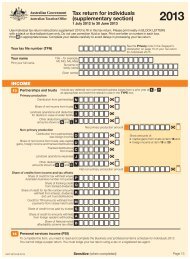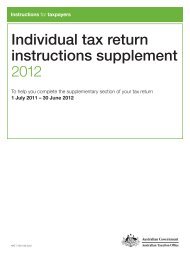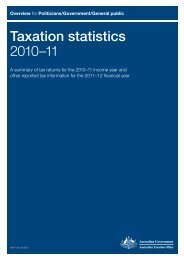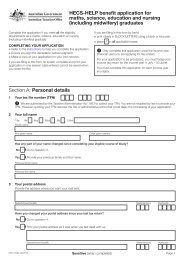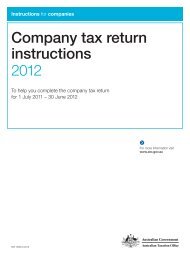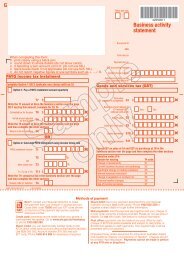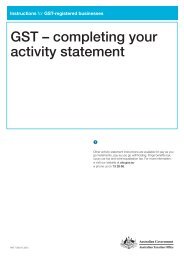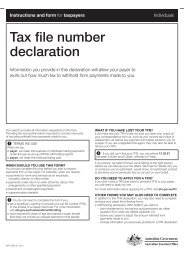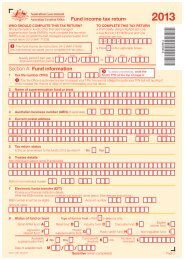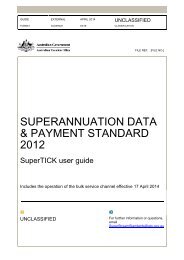The closing balance of a low-value pool for an incomeyear is:n the closing pool balance for the previous income yearplusn the taxable use percentage of the cost (first and secondelements) of any low-cost <strong>assets</strong> allocated <strong>to</strong> the pool forthe income yearplusn the taxable use percentage of the opening adjustable valueof low-value <strong>assets</strong> allocated <strong>to</strong> the pool for the income yearplusn the taxable use percentage of any amounts included in thesecond element of cost for the income year of– <strong>assets</strong> in the pool at the end of the previous income year,and– low-value <strong>assets</strong> allocated for the income yearlessn the decline in value of the <strong>assets</strong> in the pool for theincome year.EXAMPLE: Working out the closing balance ofa low‐value pool, ignoring any GST impactFollowing on from the previous example, and assumingthat John made no additional allocations <strong>to</strong> or reductionsfrom his low-value pool, the closing balance of the poolfor the 2012–13 income year would be $3,608:Closing pool balance for the 2011–12income year $5,000plus the taxable use percentage of the cos<strong>to</strong>f the printer $594less the decline in value of the <strong>assets</strong> in thepool for the income year ($1,986)Balancing adjustment event for a<strong>depreciating</strong> asset in a low-value poolIf a balancing adjustment event occurs for a <strong>depreciating</strong> assetin a low-value pool, you reduce the amount of the closing poolbalance for that income year by the taxable use percentageof the asset’s termination value. If the taxable use percentageof the asset’s termination value exceeds the closing poolbalance, you reduce the closing pool balance <strong>to</strong> zero andinclude the excess in your assessable income.A capital gain or capital loss may arise if the asset is not usedwholly for a taxable purpose. The difference between theasset’s cost and its termination value that is attributable <strong>to</strong> theestimated use for a non-taxable purpose is treated as a capitalgain or capital loss.EXAMPLE: Disposal of a <strong>depreciating</strong> asset ina low‐value pool, ignoring any GST impactFollowing on from the previous examples, during the<strong>2013</strong>–14 income year John sells the printer for $500.Because he originally estimated that the printer would onlybe used 60% for taxable purposes, the closing balanceof the pool is reduced by 60% of the termination value of$500, that is, $300.A capital loss of $196 also arises. As the printer’s taxableuse percentage is 60%, 40% of the difference betweenthe asset’s cost ($990) and its termination value ($500)is treated as a capital loss.Assuming that John made no additional allocations <strong>to</strong>or reductions from his low-value pool, the closing balanceof the pool for the <strong>2013</strong>–14 income year is $1,955:Closing pool balance for the 2012–13income year $3,608less the decline in value of the <strong>assets</strong> in thepool for the year (37.5% 5 $3,608) ($1,353)less the taxable use percentage of thetermination value of pooled <strong>assets</strong> that weredisposed of during the year ($300)This guide includes a worksheet <strong>to</strong> help you work out yourdeductions for <strong>depreciating</strong> <strong>assets</strong> in a low-value pool.IN-HOUSE SOFTWAREIn-house software is computer software, or a right(for example, a licence) <strong>to</strong> use computer software:n that you acquire or develop (or have another entity develop)that is mainly for your use in performing the functions forwhich it was developed, andn for which no amount is deductible outside the UCA or thesimplified depreciation rules for small business entities.If expenditure on software is deductible under the ordinarydeduction provisions of the income tax law, the software isnot in-house software. A deduction for such expenditure isallowable in the income year in which it is incurred.Expenditure <strong>to</strong> develop software for exploitation of thecopyright is not in-house software. The copyright is intellectualproperty, which is a <strong>depreciating</strong> asset, and the decline invalue would be calculated using an effective life of 25 yearsand the prime cost method.Under the UCA, expenditure on in-house software may bededucted in the following ways:n the decline in value of acquired in-house software, such asoff-the-shelf software, is worked out using an effective lifeof four years (if you started <strong>to</strong> hold the in-house softwareunder a contract entered in<strong>to</strong> after 7.30 PM AEST on 13May 2008 or otherwise started <strong>to</strong> hold it after that day) andthe prime cost methodn expenditure incurred in developing (or having another entitydevelop) in-house software may be (or may need <strong>to</strong> be)allocated <strong>to</strong> a software development pool; see belown if expenditure incurred in developing (or having developed)in-house software is not allocated <strong>to</strong> a software developmentpool, it can be capitalised in<strong>to</strong> the cost of a resulting unit of24 a<strong>to</strong>.gov.au GUIDE TO DEPRECIATING ASSETS <strong>2013</strong>
in‐house software and its decline in value can then be workedout using an effective life of two and a half years (or four yearsif the development started after 7:30PM AEST on 13 May2008) and the prime cost method from the time the softwareis first used or installed ready for usen if in-house software costs $300 or less and it is usedmainly for producing non-business assessable income,an immediate deduction may be allowable; see Immediatededuction (for certain non-business <strong>depreciating</strong> <strong>assets</strong>costing $300 or less) on page 9.The termination value of in-house software that you stillhold but s<strong>to</strong>p using and expect never <strong>to</strong> use again or decidenever <strong>to</strong> use is zero. As a result, you can claim an immediatededuction for the cost of the software at that time.You can also claim an immediate deduction for expenditureincurred on an in-house software development project (notallocated <strong>to</strong> a software development pool) if you have notused the software or had it installed ready for use and decidethat you will never use it or have it installed ready for use.The amount you can deduct is your <strong>to</strong>tal expenditure on thesoftware less any amount you derive for the software or a par<strong>to</strong>f it. Your deduction is limited <strong>to</strong> the extent that, when youincurred the expenditure, you intended <strong>to</strong> use the software,or have it installed ready for use, for a taxable purpose.Software development poolsThe choice of allocating expenditure on developing in-housesoftware <strong>to</strong> a software development pool was available before1 July 2001 and continues under the UCA.Under the UCA rules, you can choose <strong>to</strong> allocate <strong>to</strong> a softwaredevelopment pool expenditure that you incur on developing(or on having developed) in-house software that you intend <strong>to</strong>use solely for a taxable purpose. Once you allocate expenditureon such in-house software <strong>to</strong> a pool, you must allocate all suchexpenditure incurred in that year or a later year <strong>to</strong> a softwaredevelopment pool. A different pool is created for each incomeyear in which you incur expenditure on developing (or on havingdeveloped) in-house software.Expenditure on developing in-house software that you do notintend <strong>to</strong> use solely for a taxable purpose and expenditure onacquiring in-house software cannot be allocated <strong>to</strong> a softwaredevelopment pool.If you are entitled <strong>to</strong> claim a GST input tax credit for expenditureallocated <strong>to</strong> a software development pool, the expenditure in thepool for the income year in which you are entitled <strong>to</strong> the creditis reduced by the amount of the credit. Certain adjustmentsunder the GST legislation for expenditure allocated <strong>to</strong> a softwaredevelopment pool are treated as an outright deduction orincome. Other adjustments reduce or increase the amoun<strong>to</strong>f the expenditure that has been allocated <strong>to</strong> the pool for theadjustment year.You do not get any deduction for expenditure in a softwaredevelopment pool in the income year in which you incur it.You are allowed deductions at the rate of 40% in each of thenext two years and 20% in the year after that.If you have allocated software development expenditure ona project <strong>to</strong> a software development pool and the project isabandoned, the expenditure remains <strong>to</strong> be deducted as par<strong>to</strong>f the pool.If you have pooled in-house software developmentexpenditure and you receive consideration for the software(for example, insurance proceeds on the destruction of thesoftware), you must include that amount in your assessableincome unless you make the choice for rollover relief <strong>to</strong>apply and do so. Choice of rollover relief is only available inthis context where a change occurs in the holding of, or ofinterests in, the software; see Rollover relief on page 21.You must also include any recoupment of the expenditurein your assessable income.If the receipt of consideration arises from a non-arm’s lengthdealing and the amount is less than the market value of whatthe receipt was for, you are taken <strong>to</strong> receive that marketvalue instead.COMMON-RATE POOLSBefore 1 July 2001, certain items of plant that had the samedepreciation rate and that were used solely for producingassessable income could be allocated <strong>to</strong> a common-rate poolso that a single calculation of deductions could be made.You cannot allocate <strong>depreciating</strong> <strong>assets</strong> <strong>to</strong> a common-ratepool under the UCA. However, if you have allocated plant <strong>to</strong>a common-rate pool before 1 July 2001, you can continue<strong>to</strong> claim deductions under the UCA. The pool is treated as asingle <strong>depreciating</strong> asset and the decline in value is workedout using the following rules:n the diminishing value method must be usedn the opening adjustable value and the cost of the asse<strong>to</strong>n 1 July 2001 is the closing balance of the pool on30 June 2001n the effective life component of the diminishing value formulamust be replaced with the pool percentage you used beforethe start of the UCAn in applying the diminishing value formula for the incomeyear in which the UCA starts, the base value is the openingadjustable value of the asset, andn any second elements of the cost of <strong>assets</strong> in the pool aretreated as second elements of the cost of the pool.If a balancing adjustment event occurs for a <strong>depreciating</strong>asset in the pool or you s<strong>to</strong>p using an asset wholly for taxablepurposes, the asset is removed from the pool. The pool istreated as having been split in<strong>to</strong> the removed asset and theremaining pooled items. The removed asset is then subject <strong>to</strong>the general rules for working out decline in value or balancingadjustment amounts. The cost of the removed asset and theremaining pool is worked out using the rules for working outthe cost of a split asset; see Split or merged <strong>depreciating</strong><strong>assets</strong> on page 22.PRIMARY PRODUCTIONDEPRECIATING ASSETSThe general principles of the UCA apply <strong>to</strong> most <strong>depreciating</strong><strong>assets</strong> used in primary production.However, the decline in value of the following primaryproduction <strong>depreciating</strong> <strong>assets</strong> is worked out usingspecial rules:n facilities used <strong>to</strong> conserve or convey watern horticultural plants, andn grapevines.For <strong>depreciating</strong> <strong>assets</strong> deductible under these special rules,you cannot use the general rules for working out decline inGUIDE TO DEPRECIATING ASSETS <strong>2013</strong> a<strong>to</strong>.gov.au 25



